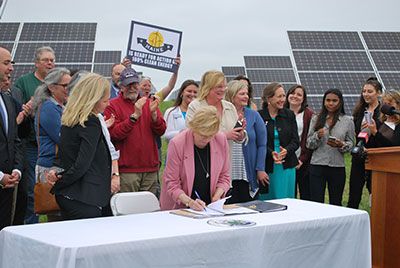
By Samantha Caputo | Sun, July 21, 19
Summer is one of my favorite times to visit Maine. With miles of white sandy beaches, quintessential New England towns, piers, lighthouses, national parks, and more, it is a great place to be. I was recently in Portland, Maine, and there was a lot of buzz about the legislative session that just closed. The amount of energy efficiency and climate legislation that was signed into public law is a breath of fresh air.
In her first year as governor in Maine, Janet Mills has made it clear that her administration is committed to addressing the threats posed by climate change. Mills joined governors from 21 other states in the United States Climate Alliance, working to meet the goals set out in the Paris Climate Accord, and the Maine legislature has responded to this leadership.

With over 10 bills signed into public law, Maine is sending a clear message that the state is joining the movement to mitigate climate change and doing its part to lessen and adapt to its impacts. From creating a Maine Climate Council, to adopting a goal of reducing greenhouse gas (GHG) emissions by 45 percent by 2030 and 80 percent by 2050 (LD1679), Maine is pulling the pieces together to decarbonize its economy.
The Maine Climate Council will establish a climate action plan which will include the transition to a clean energy economy and set compliance rules with meeting the GHG reduction targets. In addition, a 10 year energy independence plan will be completed to set conservation and renewable energy strategies for the state to become a net exporter of energy by 2030 (LD658). This plan will identify actionable policies to achieve energy independence.
Strategies that can help achieve energy independence have already been set in place this legislative session, including 80 percent of electricity sales sources from renewable energy by 2030 and 100 percent by 2050 (LD1494). Furthermore, the legislature set the bar for transitioning the heating and cooling market away from fossil fuels to renewable thermal technology by setting a target of installing 100,000 high performance air source heat pumps (ASHP) by 2025. This technology offers households and businesses a super-efficient clean energy solution to dramatically reduce the use of less efficient, carbon-intensive space heating systems while also offering efficient air conditioning.
According to Energy Information Administration (EIA), Maine does not have any crude oil reserves, refineries, or production, but nearly two-thirds of Maine households use fuel oil as their primary energy source for home heating. This is a larger share than in any other state. In order to achieve energy independence and become a net exporter, a major shift needs to happen in the building heating and cooling sector. Setting the ASHP target is the first step in this transition.
The legislature also made waves with legislation regarding the utility sector. The Public Utility Commission (PUC) is required to review the triennial plan to determine whether it will capture the maximum achievable cost-effective energy efficiency savings. One act (LD1757) requires the PUC to defer to the trust’s calculations of energy savings for the triennial plan as long as the calculations were conducted in a reasonable and transparent process. This will prevent instances like this spring where the PUC redid the energy savings calculations that Efficiency Maine Trust (EMT) had done on the claim that the Avoided Energy Supply Costs (AESC) in previous years has overstated forecasted market prices, therefore claiming that “the Trust’s ratepayer-funded budgets could have been spent on measures that were not cost-effective.” LD1757 essentially requires the PUC to embrace the discount rate and AESC values EMT previously included in its triennial plan.

Maine was an early adopter of non-wire alternatives (NWA) with the Boothbay pilot, which was very successful. Back in 2016 the PUC opened an investigation into the role of a NWA coordinator and in a bench memo by the commission staff, recommended that this position should be an entity outside of the utility. This arrangement is unique because, in most cases throughout the region, the distribution utilities are the entity that manages the NWA planning and procurement process. Yet, in this case, the Commission found that ratepayer interests would be best served by having an independent coordinator who worked in tandem with the distribution utilities.
During this 2019 legislative session, policymakers established the position of the NWA coordinator in the Office of the Public Advocates and enabled EMT to procure and deliver NWA though its triennial plan (LD1181). NWA – based on deployment of distributed energy resource – are a less costly solution to meet growing peak demand. The NWA coordinator will make recommendations regarding cost-effective NWA solutions that can replace capital investments in traditional transmission and distribution infrastructure. Energy storage is a major aspect in NWA solutions and an act (LD1614) was signed into law to study the environmental, economy, and energy benefits of storage for the state of Maine.
There is also legislation to promote solar energy and distributed generation (LD1711), and to advance building energy codes, including getting Maine caught up with the most recent building and energy codes, adopting stretch codes, and amendments to strengthen building permitting and energy code compliance (LD1509, LD1543, LD855).
All of this legislation has been signed into public law will help achieve the Governor’s goals of 80 percent renewable energy by 2030 and emissions reductions of 80 percent by 2050. It is a breath of fresh air and I am excited to see what else Maine has in store for us! In the meantime, you can find me in Portland at the Old Port.
